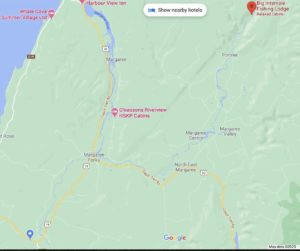On a good October day, we slip away to enjoy the beauties of Cape Breton. The blue skies and clouds are magnificent and the foliage equally so. This year, with the border restrictions, there are fewer visitors and businesses are closing early for the season, so we’ve been making the rounds of our favorite restaurants and seasonal retail stores while we can. Some photos are more ‘expressionistic’ because I took them from a moving car! The music accompaniment is a medley of two originals, “Orange on Blue” by Donna Hébert & Max Cohen, and “Long Distance” by Max Cohen. Recorded on our 2012 “Orange on Blue” CD, available in full at my digital store.
Notes from Cape Breton
9-21-2021 – Summer’s End
The apple tree in our front yard tells us fall is here. A neighbor came by the other day asking if she could glean from our tree to make hard cider. We’re looking forward to the result!
I welcome fall every year, though I mourn the light. The Margaree Valley of Cape Breton Island is a beautiful place to witness those changes. The first photos are of the Margaree River and its green and sinuous water meadows winding from the Forks to Margaree Harbour and the Gulf of St. Lawrence. Other photos are of the coast at Cheticamp and the beach at Inverness, looking toward enigmatic Margaree Island (now Sea Wolf National Refuge). The golf links shine bright green below the village of Inverness where once coal mines reached deep under the sea. Though a prettier vista than a coal mine, the grandsons of those miners now travel to Albert’s oil fields for work, so it’s a mixed blessing for their families.
Guitarist Max Cohen wrote “Sarah’s Old Piano,” for his grandmother. I somehow turned it from a march to a waltz the first time we jammed together and we recorded this track as a gift for friends in 2005. I’m looking forward to playing with him and George Wilson again in the fall.
9-12-21 – West Mabou Road
Sunny days tell us to get in the car and leave the homestead. Yesterday we went down to Port Hood via West Mabou Road and I caught these with my iPhone.
The music is my original composition, “High Street Christmas,” played with guitarist and engineer Max Cohen.
23 February 2021 – Un canadien errant revient
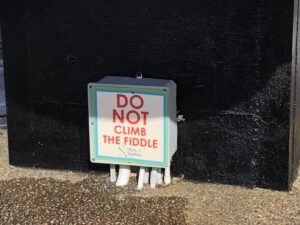
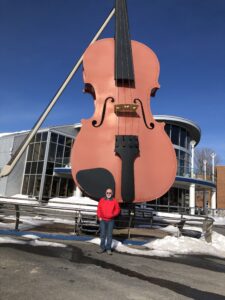 © 2021 Donna Hébert, all rights reserved.
© 2021 Donna Hébert, all rights reserved.
After more than six uninterrupted months in Cape Breton, I feel more Canadian every day, so much so that we are applying in a few weeks for my permanent residency here. The attorney who is helping us is making sure this is done right the first time. By being efficient and timely, we are saving money and precious time. To begin with, I would have tried to file the wrong form, so there’s that.
There’s also the relief of having someone to ask “So, exactly what DO they mean by this question?” as well as someone to make sure the same questions receive the same answers throughout the process of filling them in over and over in many forms. She reassures us that it’s tedious but doable, a thorough, by-the-book process and we just need to pile up documents and letters. I’ve obtained a Nova Scotia ID card and filed for my FBI check and found proof of my divorces. At 72, the girl has mileage, but at least no rap sheet other than a few traffic violations. Fingers crossed, and boy, do I feel very fortunate to be able to make this application. I know just how lucky I am and my fingers are still crossed!
Here’s the funny bit. I never thought I’d be changing borders in my seniority or that I might want to hang on to the ancient history of my divorce decree from my first husband, God rest him. I was grateful the other husbands were alive and that they cheerfully provided proof we were no longer wed, since my copies are in Massachusetts. It’s a good thing as well that Canada is only asking me to go back ten years. How would I supply addresses for where I lived in my twenties? How many times did I move? And how many lousy jobs did I do so I could play music at night? Memory draws a merciful curtain.
One delightful task asked of us was to collect a variety of photos of us doing things with people we know. That was really fun, remembering the good times and writing captions. “Proving” our relationship to Canadian Immigration this way gives us a chance to look at the pieces of our relationship closely, to see the date on the wedding cake next to my bouquet on the table, to see our friend Jane’s living room full of people who love us and were there to wish us well. These are friends we already miss and vow to stay connected to no matter what. Another requirement was to list our friends and family who knew about us and supported the relationship and the attorney said our list was far too long for what Immigration needs to see. We are blessed with many friends on both sides of the border.
This very border is something my ancestors crossed unwillingly in 1755 before it even existed and was a line on a map they passed through many times after it separated two sovereign states. Most who stayed in America just walked across or took a train to work the mills of New England before 1930. They left behind family, land, and over three generations, their French language. It was just easier. With that went much of the culture they carried and I’ve hungered for that since childhood, returning over and over to Québec to find the missing pieces of who I am. Now I’m planted firmly in Acadia, where it seems my people began their association with North America in the early 1600s. Adventurous lot. Gratefully bolstered in the 21st century by central heating and a full larder, I embark on my own adventure.
Like the pandemic, this will be a year of waiting with a hopeful ending. We await a few final documents before filing the application and once it’s done, we sit tight for a year. Soon, I’ll be able to call one place home, to feel grounded, rooted here. I’m going to get a jump start on that this spring, when I’ll put my hands into northern earth and make some nice tall sunflowers grow.
Un Canadien errant revient.
11-25-2020 – A Doggedly Grateful Thanksgiving
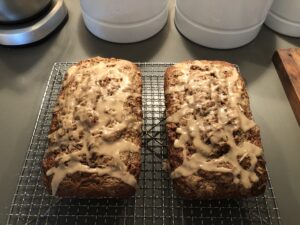 There’s still a lot to be worried about right now but some things are beginning to look better. A vaccine is coming and a cruelly uncaring president is going, neither soon enough to save lives or to satisfy the need for immediate change.
There’s still a lot to be worried about right now but some things are beginning to look better. A vaccine is coming and a cruelly uncaring president is going, neither soon enough to save lives or to satisfy the need for immediate change.  Trying to craft a non-dairy dessert with no milk, cream, or butter, I’ve come up with an applesauce almond cake with an almond cinnamon glaze. I think it would work well with almond flour and fine cornmeal in place of the wheat flour but I haven’t tried it. The applesauce is made from our Scotia Gold apple harvest and it’s naturally sweet, so good that we still have a bucket of apples on the screen porch and grab one when we walk through. The recipe has very little oil or sugar in it. Applesauce takes the place of fats and provides sugars and ensures a nice crumb and a moist cake that lasts as long as you can ration yourself. It also freezes well. We made two loaves and froze one to give a friend. Then we ate it. I’ll have to make some more.
Trying to craft a non-dairy dessert with no milk, cream, or butter, I’ve come up with an applesauce almond cake with an almond cinnamon glaze. I think it would work well with almond flour and fine cornmeal in place of the wheat flour but I haven’t tried it. The applesauce is made from our Scotia Gold apple harvest and it’s naturally sweet, so good that we still have a bucket of apples on the screen porch and grab one when we walk through. The recipe has very little oil or sugar in it. Applesauce takes the place of fats and provides sugars and ensures a nice crumb and a moist cake that lasts as long as you can ration yourself. It also freezes well. We made two loaves and froze one to give a friend. Then we ate it. I’ll have to make some more.10-18-2020 – Blessing
© 2020 Donna Hébert, all rights reserved.
Blessings come in large and small packages. We are thankful for this week’s heavy rain, which has fully recharged the cistern. It’s a partial blessing since we also await the results of the tested water and are drinking bottled water in the meantime.
A week of dreich (Scots Gaelic for gloom) has been followed by several days of great weather, so we do our errands up and down the coast, from Chéticamp to Port Hawkesbury. I never leave my phone at home any more because there are too many pictures already framed and waiting for me to find them.
We take advantage of these mild fall days to ready the house for winter and plan out next year’s garden. But the blessings of fall are fleeting in their beauty and provide a perfect excuse to walk away from the computer. The wind in our faces also pushes the scudding clouds across a cerulean fall sky, with the Bay of St. Lawrence reflecting that blue to the horizon. Shading our eyes against the late afternoon sun with the maples on fire, we can just breathe in the beauty and let it reach all the way to the tightness inside. The landscape draws it out and by the time we arrive home, we feel better.
Today’s slideshow covers several journeys over the past few weeks up and down the coast, from Chéticamp south to the Margarees, along the beach at Inverness, the harbour and marsh at Mabou, visiting beaches at Port Hood and Port Hastings. This western area has several names – the Musical Coast, the Ceildh Trail, the Sunset Coast. All are accurate. There is much to see and hear in this slice of Cape Breton and we’re trying to pack as much as we can into only a few more months. https://youtu.be/Tp5E97S_YcU
The song, Blessing, was written for a friend’s 40th birthday and I sing it on my 1999 Big Boned Beauty recording. Tom Hodgson plays guitar with Lise Brown on tenor sax. I also fiddled and sang harmony on Blessing with Lui Collins and Max Cohen in 2017. Lui, (who sings it way better than I do!) sings lead vocal and plays ukulele, Max is on guitar and vocal. We performed this in shows with Jane Yolen and 3 Ravens.
Of all my songs, Blessing has a life of its own and has been recorded so many times that I’ve lost count, though Lui was one of the first, on her Stone by Stone CD.
Maybe it works. Take a moment. Relax. Enjoy the view. Breathe.
Blessed Be.
10-11-2020 – Well, Well, Well
© 2020 Donna Hébert, all rights reserved.
 This week in Cape Breton was all about water.
This week in Cape Breton was all about water.
Monday morning . . . The good news is that the spring is recharging our cistern, though very slowly. With rain predicted for the next four days, we have our fingers crossed. We both took showers and did a small wash yesterday and now the water from the faucet doesn’t look drinkable, so we’re using stored or bought water for consumption. We’ll stagger our showers and continue to wash dishes by hand. No clothes-washing until the cistern is higher. In the short term, we have friends and neighbors who can refill our containers if that becomes necessary.
As a long-term solution, we can sink a much deeper well, so the bad news starts at $4,500 and can go much higher. Gulp. Our current water supply comes from a spring feeding into a cistern. There were drought conditions here throughout the summer and it’s been running low since we arrived in August. Global warming doesn’t improve the future outlook, so sinking a well might become necessary.
Thursday morning . . . It’s been raining off and on since Tuesday. This morning we had some hard rain for a few minutes and it’s returned a few times but it’s better like this, raining gently all day so it sinks into the earth instead of running off. The cistern has been recharging enough to shower and use the faucet for drinking as we had a half inch of rain two days ago and another 9/10 inch today so far. Bob has a weather station on the hill and he checks the cistern daily so we don’t get too low. I realize this sounds as tedious as watching the cracks dry up after it rains but I assure you it’s riveting to find out whether or not you can actually take a shower!
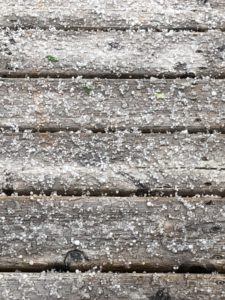 Friday morning . . . Wow! That wind is crazy and it’s just getting wilder. The Canadian weather service predicted flurries (their butch term for anything under a foot of snow) in the Cape Breton Highlands but here, we had “Oh, the wind and rain” all day, all night, gusting to 90 kph, and it’s still storming mightily. The photo shows what the hailstorm left behind on the deck outside my office. It wasn’t sleet. It was almost 50 degrees at the time and each spattering melted immediately. There were at least ten bursts of hail before the day was over but no rain of frogs so far. At least we didn’t get the snow that Antigonish got 2 hours south of us. They had to cancel their golf tournament. Have I mentioned that Cape Breton seems to fall in the center of a Venn diagram of weather? Yeah, just wait a minute . . .
Friday morning . . . Wow! That wind is crazy and it’s just getting wilder. The Canadian weather service predicted flurries (their butch term for anything under a foot of snow) in the Cape Breton Highlands but here, we had “Oh, the wind and rain” all day, all night, gusting to 90 kph, and it’s still storming mightily. The photo shows what the hailstorm left behind on the deck outside my office. It wasn’t sleet. It was almost 50 degrees at the time and each spattering melted immediately. There were at least ten bursts of hail before the day was over but no rain of frogs so far. At least we didn’t get the snow that Antigonish got 2 hours south of us. They had to cancel their golf tournament. Have I mentioned that Cape Breton seems to fall in the center of a Venn diagram of weather? Yeah, just wait a minute . . .
Saturday morning . . . Bob checked the cistern level and it’s up fifteen inches so we are out of the woods for the moment. We’re still filtering water for drinking because it looks a little cloudy but hallelujah! Showers are possible and as soon as the sun shines, we’ll do a wash and hang it out.
If your home uses town or city water, you may have problems other than a cistern running low. Flint, Michigan residents are still afraid to drink the water that comes out of the tap after six years of remediation. Wherever you live, maybe you wonder what they put in the water to make it potable and maybe you also wonder why is it so fishy-tasting and you filter it anyway just in case. Here, though the water is pure, cold, and delicious, a well might be needed because this year’s drought is a taste of the future. If my residency is approved, we’ll also be here year-round, using more water and tending the large garden we hope to grow with water from that spring.
We take it for granted on the east coast but clean, fresh water is our most precious natural resource. Access to water will determine the future of all civilization, just as it has in the past. Ghost cities in the African deserts, the American southwest, and the jungles of Central America are evidence of what happens when we outgrow our water resources. At rock bottom, we can’t grow food and society collapses.
Our fresh waters are ever more endangered and we certainly can’t use them up in some Biblical fantasy of dominion and redemption. People who don’t believe in that particular story also need the water, dammit, so religion just exacerbates the problem rather than solving it. Remember those ghost cities? They’re a warning.
I’m concerned about conservation and I favor public over private ownership of aquifers and lakes, rivers and streams. That means leaving forests alone so watersheds are protected. It means refusing to allow something universally required for life – water – to become the exclusive property of Nestle or some other international company, who packages it in plastic and sells it back to us at great cost to us and the planet.
Nestle’s CEO has been quoted as saying that we as individuals do not have an absolute right to water, that we must buy it, with the implication that when there is none other to be had, we can buy it from them, or die. I don’t think so. We need to protect that water for all life and for future generations on the planet. It’s far too valuable to squander for corporate profit.
Water is the true elixir of life and of course, you can’t make decent whiskey without it!
10-5-2020 – Big Intervale on the Northeast Margaree River
© 2020 Donna Hébert, all rights reserved.
The longest so far, this slideshow has 52 images and the music (4:40) is the Québecois waltz via Jean Carignan and Willy Ringuette, “La Valse Joyeuse,” from my 2009 In Full Bloom CD. I play this with pianist Rachel Aucoin and button accordionist Sabin Jacques. https://youtu.be/Utdp-MbA1Ew
Margaree is almost a generic term here. “Where do you live,” people ask, and I have to think a moment. “Southwest Margaree,” I answer. But it’s not that simple. We’re on the West Side of Southwest Margaree and it took me awhile to figure out that’s what WSSW Margaree meant on the road sign. There’s an East Side of Southwest as well, on the opposite side of, you guessed it, the Margaree River. But just which Margaree River am I referring to? Technically, there are three of them!
Bob has been taking me around the Margarees, their collective name, for several years. There seemed to be a lot of them, though I knew his home was in Southwest Margaree. There are actually nine Margarees. I looked them up. Only one of them, Upper Margaree, is on “upper” part of the Southwest Margaree River, which, despite the name, is the farthest south of all the other Margarees, as the SW Margaree River flows northeast out of Lake Ainslee toward Margaree Forks, where it joins with the Northeast Margaree to become the Margaree River, flowing toward Margaree Harbour and emptying into the Gulf of St. Lawrence. All the other Margaree villages are situated along the Northeast Margaree River. Got that? It might just be easier to explain that a river runs through it every which way. Or show you a map . . .
Today, we got into the woods a little more, grabbed sandwiches at The Dancing Goat in Northeast Margaree, and headed toward Big Intervale, source of the NE Margaree River, from the blue dot on the lower left to the red dot in the upper right of the map, following the river/s. The road turns to gravel quickly when you leave the Cabot Trail, but we’ve seen a lot worse. Nice and wide, it narrows at the end, following the river, where it ends at Big Intervale Fishing Lodge. Everyone is obliged to turn around in the lodge’s front yard to go back where they came from.
There was one way in and the same way back, yet it looked different and I noticed little things that I’d missed on the way in, like the fact that they didn’t bury the wires and the trees are pretty thick so anyone who lives there in any season must be equipped with a generator. I also got to thinking about how much simpler the homes were than the glassy showplaces on the ocean bluffs. It’s a whole other island up in the woods. Don’t forget your rod, your reel, and your bug suit. You can fish with a license along the river as long as you can find a safe place to park and you can keep the trout you catch, but the salmon are catch and release.
We stopped at every bridge to examine the waters that go into making a river, noticing many fingerling trout in the shallows (salmon hide in the deeper pools), and we looked around many country corners. The light was quixotic, with cloud cover moving away quickly and the sun blazing through, only to hide a moment later. There was something new around every bend in the road.
